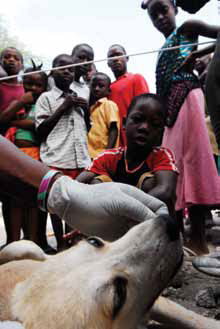Animal rescue coalition concludes Haiti relief work
More than a year since the magnitude 7.0 earthquake that devastated Haiti Jan. 12, 2010, relief efforts have succeeded in helping the nation's animal and human populations recover.
The Animal Relief Coalition for Haiti announced May 3 that it has met all six objectives outlined in its $1.1 million agreement that was established March 4, 2010, with the Haitian government. The overall aim of the relief effort was to improve animal welfare conditions, repair the country's damaged veterinary capacity, and have a long-lasting impact on animals and people following the devastating earthquake. The completion of the objectives marks the end of the coalition's work in Haiti, according to an ARCH press release.

Formed just days after the quake, ARCH was led by the World Society for the Protection of Animals and the International Fund for Animal Welfare. The coalition comprised more than 20 of the world's leading animal welfare groups, including the AVMA and American Veterinary Medical Foundation. It was the only coalition that set out to provide relief for the animal survivors in Haiti and address the threat of disease spreading from animals to humans.
After running operations seven days a week for the past year, ARCH stepped aside for the Haitian government to continue addressing animal needs through its Ministry of Agriculture, Natural Resources, and Rural Development.
ARCH's mobile veterinary clinic treated close to 68,000 animals, including dogs, cats, horses, cattle, pigs, goats, and sheep in the greater metropolitan area of Port-au-Prince as well as other quake-impacted areas such as Carrefour and Leogane. Teams treated injured and sick animals with medications including antimicrobials and deworming medicine. Hoofstock were administered anthrax vaccines, and dogs and cats were vaccinated against rabies (see JAVMA, April 1, 2010).
The following additional objectives were met during the past year of operations:
- Replenished veterinary infrastructure and supplies by helping rebuild the National Veterinary Laboratory, installed 12 solar-powered refrigeration units critical for animal vaccine storage, and trained veterinarians to deal with disaster situations in the future.
- Promoted pet care and animal welfare education by launching a public awareness campaign about disaster preparedness and health issues related to Haiti's livestock and pets and worked closely with the ministry to include animal welfare in Haiti's educational curriculum for children ages 8 to 12.
- Protected the health of humans by vaccinating Haiti's animal population against diseases such as rabies and Newcastle disease and treated animals for parasites.
- Conducted the first of its animal population and attitude surveys in Port-au-Prince to obtain critical information on animal numbers, health-related data, and human-animal interactions.